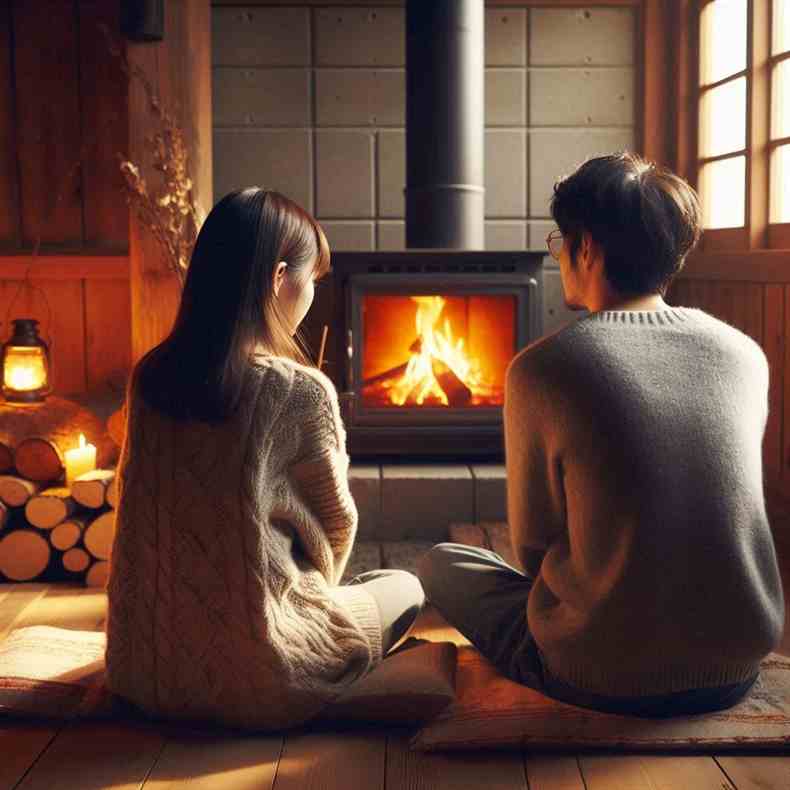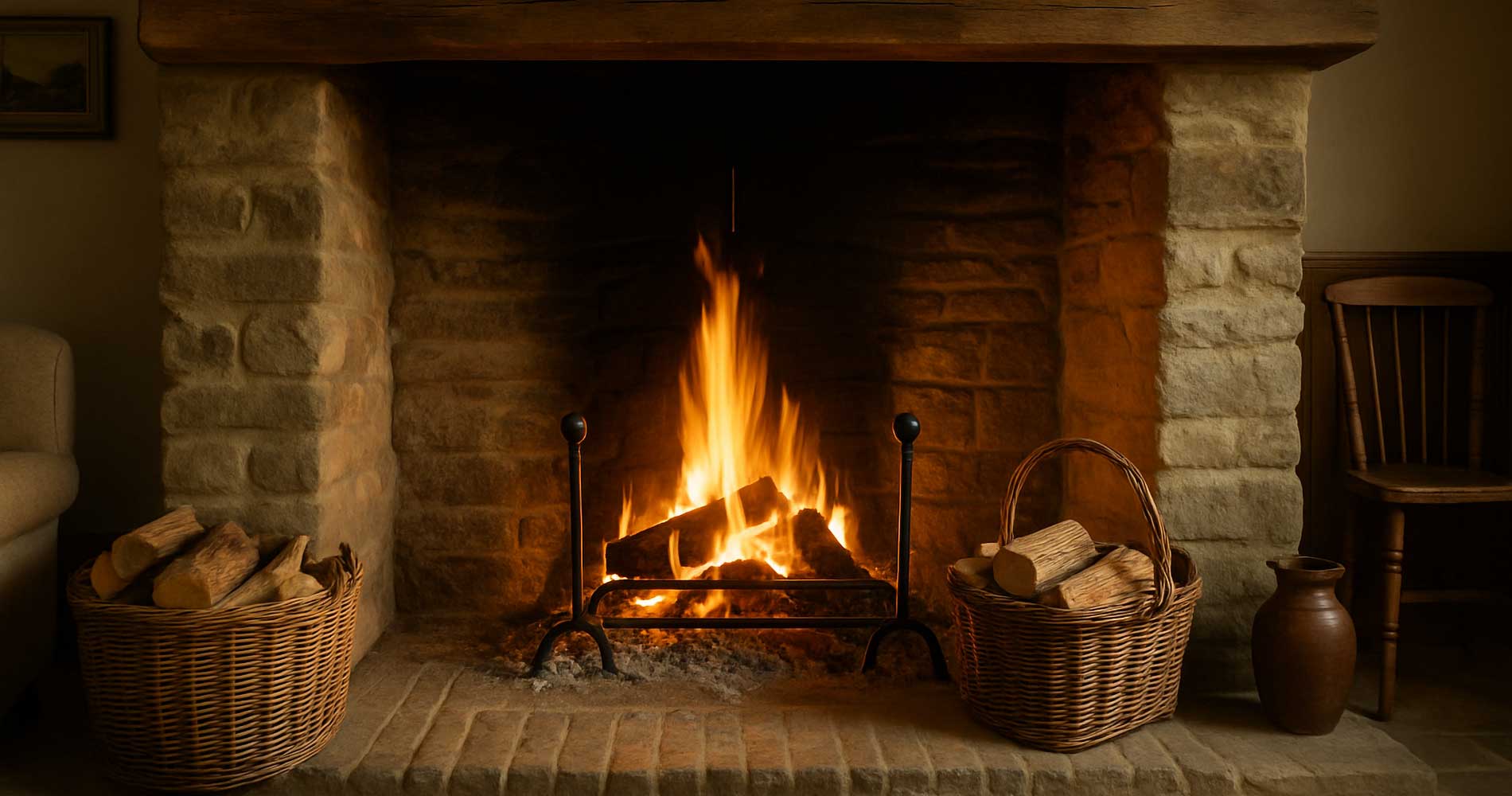It All Began With a Spark
Long before Netflix, sofas, or scented candles — before walls, even — there was fire. Not just any fire, though. A carefully tended flame, built in a pit or stone ring, flickering at the centre of a shelter. That was the world’s first fireplace. Simple, essential, powerful.
In a time when survival meant battling the elements every day, fire was more than warmth. It was safety. Light. A way to cook and share food. And perhaps most importantly — it was a reason to gather. You sat by the fire not just to survive the cold, but to feel human. To belong.
The Hearth as Heart: Life Around the Flame
Imagine life thousands of years ago. Your home is a hut, cave, or lean-to made of wood and stone. Outside, wind and wild animals wait. Inside, the fire burns softly. It cracks and hisses. It keeps the darkness back — both the kind you can see and the kind you can feel. That fire? It becomes the centre of everything.
It’s where you warm your hands. Cook your meals. Tell your stories. The hearth, even in its earliest form, was a deeply emotional place. It grounded you. Literally and spiritually.
- Fire kept you alive — by heating your space and cooking your food
- It created social bonds — families and tribes gathered around it every evening
- It offered a sense of time — day ended when the flames were banked
And even now, thousands of years later, we still carry that instinct. We feel more at ease in a room with a fire. We speak softer near the glow. Some things don’t change — and maybe they shouldn’t.
Stone Age Ingenuity: The First Fire Pits
The earliest evidence of indoor hearths goes back nearly 400,000 years. Yes, really. In places like Qesem Cave in Israel and sites across Europe, archaeologists have found soot marks, charred bones, and rings of burnt stone — proof that our ancestors had mastered the art of indoor fire long before cities or farming.
These early fireplaces were simple:
- Shallow pits dug into the floor
- Rings of stone to contain the flame
- Strategically placed for warmth and ventilation
No chimneys yet, of course. Just a hole in the roof or smoke seeping out through a gap in the wall. You can imagine the coughing — but also the comfort. Even then, the fire meant home.

Ancient Civilisations: When Fire Became Sacred
As humans began to settle and build permanent homes, fire’s role became more complex. In ancient Greece, the hearth wasn’t just practical — it was spiritual. The goddess Hestia, keeper of the hearth, symbolised domestic life and stability. Every home had a fire dedicated to her. And in public spaces? There were communal hearths where people gathered to make offerings and mark important events.
The Romans carried on this tradition. Their homes featured central hearths, and many wealthier households added ornate braziers and hypocaust heating systems — an early version of underfloor heating.
Even then, fireplace design was evolving. It wasn’t just about function anymore. It was about form. About reverence. About how fire made you feel.
Medieval Fires: Bigger Flames, Bigger Rooms
Jump ahead to the early Middle Ages, and the fire is still centre stage — though now it’s under a massive open roof in a castle hall. Picture this: a great hearth on the floor, smoke curling up to dark wooden rafters, lords and ladies huddled close while servants bustle about.
No chimney yet, but progress is coming. By the 12th century, chimney flues began to appear. These allowed fireplaces to be placed against walls instead of in the middle of the room. Suddenly, layouts changed. Privacy became possible. The fire could move — and so could the family structure.
- Wall-mounted fireplaces replaced central fire pits
- Rooms could be divided and heated individually
- Fire became a personal experience, not just a shared one
It was a big shift. One that laid the groundwork for everything we recognise in modern home design today.
The Hearth as a Symbol of Health and Wholeness
By now, you're probably sensing a theme. The fireplace has never just been about heat. It’s always been emotional. Ritualistic. Tied to our health and our sense of balance.
In many cultures, the hearth was believed to have healing properties. People would sit near it to ease physical pain, or stare into the flames to soothe anxiety — something we still do, whether we realise it or not. The flicker helps regulate our nervous system. The warmth eases muscle tension. It invites stillness in a fast-moving world.
Even now, in digital spaces and wellness-focused interiors, fireplaces are being reimagined to support mental wellbeing. They’re used to create grounding rituals. To mark the end of a day. To hold space for conversations that matter.
So... What Changed?
Well, in one sense, everything. We’ve swapped out logs for LEDs. Built fireplaces into walls instead of digging them into floors. We've made them smarter, cleaner, quieter.
But in another sense? Nothing’s changed. Not really. We still crave that central point. That soft light and steady warmth. We still gather around it. Alone or with others. Silently or in deep conversation.
- Fireplaces still anchor our homes — even if they’re electric now
- They still help us pause — even when the rest of life demands speed
- They still offer comfort — which, let’s be honest, is something we all need
Final Thoughts: Echoes of the Ancient Hearth
The next time you sit by a fire — real or digital, wood or gas — take a moment. That quiet you feel? That sense of arriving, of being held? It’s not new. It’s ancient. You’re part of a story that stretches back through caves and temples, castles and cottages. You’re sitting where countless others have sat, with the same hopes. The same fears. The same longing for warmth, safety, peace.
The fireplace may have changed shape. But its purpose? That’s stayed the same.
